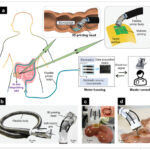2023-02-27 ペンシルベニア州立大学(PennState)
この研究は、米国科学アカデミー紀要に掲載された新しい論文、”Integrating pH into the metabolic theory of ecology to predict bacterial diversity in soil” に収録されています。
<関連情報>
- https://www.psu.edu/news/research/story/new-predictive-models-developed-bacterial-diversity-soils/
- https://www.pnas.org/doi/10.1073/pnas.2207832120
土壌中のバクテリアの多様性を予測するために、pHを代謝生態学理論に統合すること Integrating pH into the metabolic theory of ecology to predict bacterial diversity in soil
Lu Luan ,Yuji Jiang,Francisco Dini-Andreote ,Thomas W. Crowther,Pengfa Li,Mohammad Bahram ,Jie Zheng,Qinsong Xu ,Xue-Xian Zhang ,Bo Sun
Proceedings of the National Academy of Sciences Published:January 10, 2023
DOI:https://doi.org/10.1073/pnas.2207832120
Significance
Understanding the mechanisms structuring soil bacterial diversity is central to predicting how organisms and communities respond to biotic/abiotic disturbances. Metabolic theory has provided a framework to explain patterns of physiology and diversity in ecological communities. We established a quantitative model to incorporate pH into metabolic theory to capture some of the unexplained variation in bacterial diversity across scales. We combined laboratory experiments at the level of a single species with meta-analysis at the level of community at continental and global scales to build predictive models of species and community diversity. The conceptual framework firstly incorporated pH into metabolic theory to advance accuracy in model predictions of bacterial diversity. Our study allows for further incorporation of multiple factors into MTE-based models.
Abstract
Microorganisms play essential roles in soil ecosystem functioning and maintenance, but methods are currently lacking for quantitative assessments of the mechanisms underlying microbial diversity patterns observed across disparate systems and scales. Here we established a quantitative model to incorporate pH into metabolic theory to capture and explain some of the unexplained variation in the relationship between temperature and soil bacterial diversity. We then tested and validated our newly developed models across multiple scales of ecological organization. At the species level, we modeled the diversification rate of the model bacterium Pseudomonas fluorescens evolving under laboratory media gradients varying in temperature and pH. At the community level, we modeled patterns of bacterial communities in paddy soils across a continental scale, which included natural gradients of pH and temperature. Last, we further extended our model at a global scale by integrating a meta-analysis comprising 870 soils collected worldwide from a wide range of ecosystems. Our results were robust in consistently predicting the distributional patterns of bacterial diversity across soil temperature and pH gradients—with model variation explaining from 7 to 66% of the variation in bacterial diversity, depending on the scale and system complexity. Together, our study represents a nexus point for the integration of soil bacterial diversity and quantitative models with the potential to be used at distinct spatiotemporal scales. By mechanistically representing pH into metabolic theory, our study enhances our capacity to explain and predict the patterns of bacterial diversity and functioning under current or future climate change scenarios.



